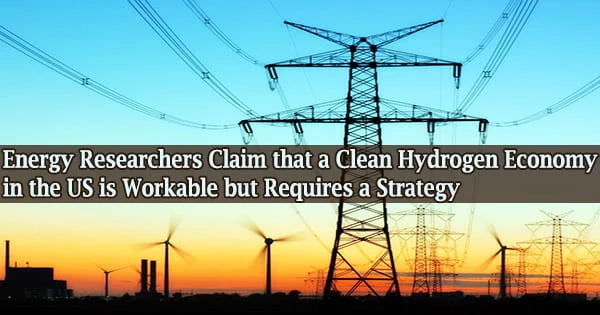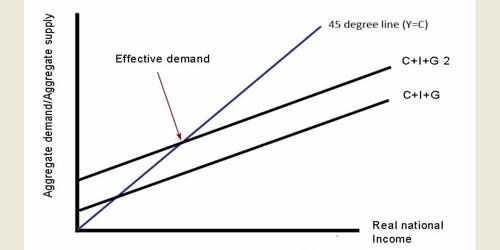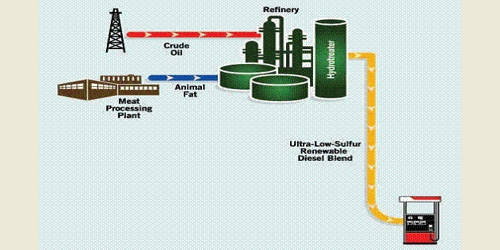In addition to a clean electrical system, reducing emissions from industrial heat, long-distance heavy transportation, and long-duration energy storage are all necessary to combat climate change.
According to a Commentary published on August 11 in the journal Joule, that fuel might be hydrogen and its derivatives, but a clean U.S. comprehensive strategy and a 10-year plan will be needed for the H2 economy.
The essay contends that efforts to make clean H2 economically feasible on a large scale will fail without comprehensive consideration of future H2 infrastructure, including production, transport, storage, use, and economic viability.
“We applaud the U.S. Secretary of Energy, Jennifer Granholm, for launching the ambitious Hydrogen Earthshot program with a technology-agnostic stretch goal of greenhouse gas-free H2 production at $1/kg before the end of this decade,” write Arun Majumdar, a Jay Precourt Professor and Co-Director of the Precourt Institute for Energy at Stanford University and lead author of the commentary, and colleagues.
“Similar R&D programs with techno-economic stretch goals are needed for H2 storage, use, and transport as well. The Hydrogen Earthshot is necessary to create a hydrogen economy, but it is not sufficient.”
Each year, roughly 70 million metric tons of H2 are created worldwide, with the U.S. producing about one-seventh of that total. Nearly majority of this H2 is classified as “gray H2,” which costs just around $1 per kilogram to manufacture but has about 10 kilos of CO2 baggage per kilogram of H2 and is used to make fertilizer and petrochemicals.
“An H2 economy already exists, but it involves lots of greenhouse gas emissions,” says Majumdar. “Almost all of it is based on H2 from methane. A clean H2 economy does not exist today.”
Researchers have many vivid ideas for what a clean H2 economy may resemble. By absorbing CO2 and lowering emissions, “Blue H2,” for instance, produces H2 with a lower greenhouse gas production.
Hence, it is important to explore alternative approaches for a hydrogen economy that does not require a new H2 pipeline infrastructure. Instead, it is worth using existing infrastructure to transport the feedstock for H2 electric grid for transporting electricity for water splitting; natural gas pipelines to transport methane for pyrolysis.
Arun Majumdar and colleagues
Not accounting for the cost of creating the pipes and sequestration equipment required to transport and store unwanted CO2, it is now roughly 50% more expensive than gray H2.
“To make blue H2 a viable option, research and development is needed to reduce CO2 capture costs and further improve capture completeness,” write Majumdar and colleagues.
Scientists are also interested in “green H2,” another type of pure H2. Green H2 includes splitting water without the production of greenhouse gases, using electricity and electrolyzers.
However, the price ranges from $4 to $6 per kilogram; Majumdar and colleagues propose that this price might be lowered to under $2 per kilogram by lowering the price of carbon-free power and electrolyzers.
In the field of science, “turquoise H2,” which is produced by methane pyrolysis when methane is broken to produce greenhouse gas-free H2, is also making waves.
Although Majumdar and colleagues point out that the amount of solid carbon produced at the requisite scale would exceed present demand, necessitating R&D efforts to create new markets for its utilization, the solid carbon co-product generated in this method may be sold to help offset expenses.
Greenhouse gas-free (and, in fact, colorless) H2 or its derivatives could be utilized for transportation, the chemical reduction of captured CO2, long-term energy storage in a grid that is heavily dependent on renewable energy sources, chemical reductants for steel and metallurgy, as well as high-temperature industrial heat for the production of glass and cement.
But in order for these uses to materialize, H2 production must meet specific cost benchmarks, such as $1 per kilogram for usage in fuel cells, ammonia synthesis, and petrochemical manufacture.
The researchers also stress the necessity for the U.S. to think about how pipelines will be created and put into use in order to transport H2 as well as how to store H2 in an efficient manner on a wide scale.
“Developing and siting new pipeline infrastructure is generally expensive and involves challenges of social acceptance,” write Majumdar and colleagues.
“Hence, it is important to explore alternative approaches for a hydrogen economy that does not require a new H2 pipeline infrastructure. Instead, it is worth using existing infrastructure to transport the feedstock for H2 electric grid for transporting electricity for water splitting; natural gas pipelines to transport methane for pyrolysis.”
“While there has been some systematic study of geological storage, the United States Geological Survey should be charged with undertaking a national survey to identify the many locations where underground storage of hydrogen is possible while also considering the infrastructure costs needed to use these caverns,” the researchers add.
















